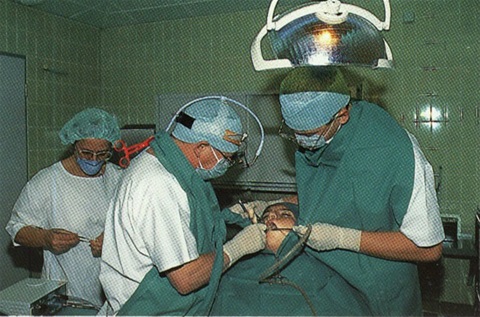Introduction
Oral and maxillofacial specialty undergo dramatic advancement in the knowledge and techniques in the last few years. The scope of practice for oral and maxillofacial surgeons have been broadened. Moreover, the area of maxillofacial practice among the Egyptian specialties have become wider and wider during the last few years. Still moreover, maxillofacial practical is not confined to the maxillofacial surgeons. Plastic surgeons, general surgeons, otolaryngeal surgeons and oral surgeons are all participating in practice. Thus it has been increasingly necessary for the oral and maxillofacial surgeons to have a reference that can be consulted. Such reference must be complete and comprehensive as well as practical and readable.
ORAL SURGERY AND LOCAL ANAESTHESIA - DSC 401
Course Title: Oral Surgery and Local Anaesthesia
Course Code: DSC 401
Units: 3
Year of Study: BDS IV
Mode of Delivary:
- Tutorial Session
- Clinical Session
- Overview Lectures and Seminars
Mode of Assissment
- Continous Assessment Test
- End of year exam, written, clinical and viva voc
Learning Outcomes:
Course Content:
Local anesthesia: Pain and pain control. The trigeminal nerve. Regional anaesthesia general consideration. Local anaesthetic drugs. Management of patients receiving local anaesthesia. Injection techniques. Local anesthetic complications.
- Extraction of teeth: Intralveolar extraction of teeth. Transalveolar extraction of teeth. Complication of extraction.
- Removal of impacted teeth: Definition. Etiology. Frequency. Complications. Indications for removal. Classification. Surgical removal of impacted teeth. Surgical complication during removal of impacted teeth.
- Salivary glands disorders:
- Diagnosis of salivary glands disorders: clinical examination of major and minor salivary glands. Radiographic examination of salivary glands. Sialography. Computed tomography. MRI. Radioisotope scan. Biopsy of salivary glands.
- Disorders of salivary glands: functional disorders. Obstructive disorders. Inflammatory disorders. Neoplastic disorders.
- Surgical treatment of salivary glands disorders: removal of mucoceles. Removal of ranula. Sialolithotomy surgical excision of submandibular gland. Parotidectomy. Complication of salivary glands surgery.
- Diagnosis and management of facial pain: examination and classification of facial pain. Differential diagnosis of facial pain. Trigeminal neuralgia.
- Management of patients with systemic diseases: cardiovascular disorders. Liver diseases. Endocrine diseases. Blood disorders. Sexually transmitted diseases. Other systemic diseases.
- Principles of drug use in oral surgery: Anti-infective agents. Analgesic agents.
ORAL AND MAXILLOFACIAL SURGERY - DSC 501
Course Title: Oral and Maxillofacial Surgery
Course Code: DSC 501
Units: 4
Year of Study: BDS V
Mode of Delivary:
- Tutorial Session
- Clinical Session
- Overview Lectures and Seminars
Learning Outcomes
- Have knowledge of diagnostic modalities necessary for surgical disorders affecting oral and paraoral region.
- Be competent at executing surgical treatment for simple and moderate cases.
Course Content
- Maxillary sinus disorders: General considerations. Maxillary sinusitis and tumors of the maxillary sinus. Management of oro-antral communications and root displacement in the maxillary sinus.
- Preprosthetic surgery: Criteria of ideal ridge. Classification. Prevention and corrective procedures: routine measures. Alveoloplasty and alvelotomy. Corrective procedures: soft tissue surgery. Hard tissue surgery. Combined hard and soft tissue surgery. Ridge atrophy procedures: vestibuloplasty. Ridge augmentation. The use of implants.
- Implantology: Types of dental implants. Classification. Osseointegeration. Diagnosis and treatment planning. Surgical procedures for endosseous implants. Clinical applications for dental implants. Success and failure of dental implants. Complications.
- Orthognathic surgery: Diagnosis and treatment planning. Correction of mandibular and maxillary deformities. Segmental alveolar surgery. Management of open bite and chin deformity.
- Temporomandibular joint disorders: Ankylosis: Etiology. Signs and symptoms. Radiographic examination. Treatment. Functional disorders: Clicking. Myofascial pain dysfunction syndrome. Dislocation. TMJ arthritis: classification. Degenerative arthritis. Traumatic arthritis. Other forms of arthritis.
- Cysts of the oral and paraoral region: Diagnosis modalities of cysts and cyst like lesions: Signs and symptoms. Radiographic examination. Biopsy taking and interpretation of aspiration biopsy. Basic surgical techniques for treatment of cysts: Marsupialization. Enucleation. Clinical applications: Odontogenic keratocysts. Nonkeratinizing odontogenic cysts. Non-odontogenic cysts. Bone cysts. Complication of cysts and cyst treatment.
- Fracture of facial bones: First aid of traumatized patient. Principles of facial fracture treatment: Reduction. Fixation. Immobilization. Rehabilitation. Mandibular fracture: surgical anatomy. Applied anatomy. Etiology. Classifications. Factors affecting displacement. The problem of a tooth in the fracture line. Diagnosis. Management. Middle third fracture: Etiology. Surgical anatomy. Classifications. Dentoalveolar fracture. Diagnosis and management. Post-operative care of facial fracture patient. Complications.
- Tumors of the oral cavity: Definition. Classification. Biopsy techniques. Modalities of treatment. Classification of surgical procedures used.
- Infection of oral and paraoral region: Etiology. Spread of odontogenic infection. Non-specific infection: Dentoalveolar abscess. Pericoronitis. Fascial spaces. Ludwig’s angina. Cavernous sinus thrombosis. Mediastinitis. Carotid sheath invasion. Osteomyelities and osteoradionecrosis. Specific infections.
- General anaesthesia and sedation: Introduction. Pre-anesthetic evaluation. Preoperative preparation and premedication. Anesthetic equipment. Anaesthetic drugs. Sedation techniques. Complications of general anesthesia and sedation. Cardiopulmonary resuscitation (CPR).
